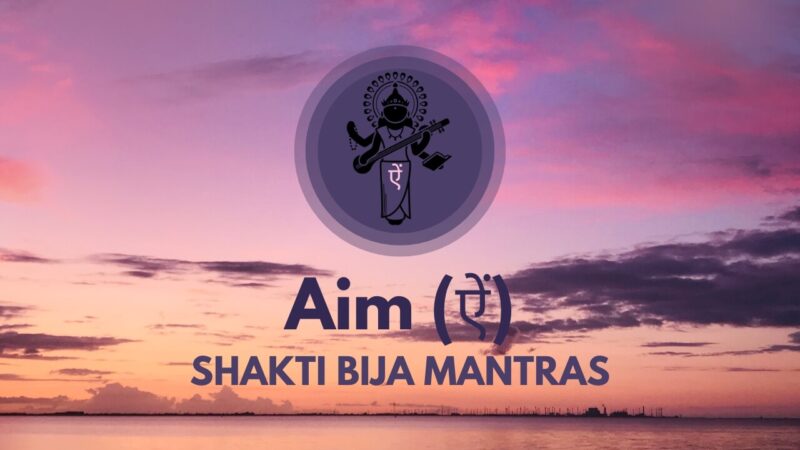Bija mantras, often called “seed sounds,” have their roots in ancient Vedic traditions and are known for their immense spiritual and energetic power. Each Bija mantra represents a deity, an element of nature, or a chakra, making them highly versatile in meditation, yoga, and spiritual practice.
In this article, we’ll cover the different types of Bija mantras, their meanings, and how they can positively affect your life.
Bija mantras are one-syllable sounds that serve as the foundation of more complex mantras. The word “Bija” means “seed” in Sanskrit, and just as a seed grows into a tree, the chanting of Bija mantras is believed to grow one’s spiritual energy.
The vibrations produced by chanting these mantras resonate throughout the body, helping you connect to higher consciousness, calm the mind, and open blocked energy pathways.
Types of Bija Mantras
There are various types of Bija mantras, each serving a different purpose. These mantras can be categorized based on the deities, elements, or chakras they are associated with.
1. Shakti Bija Mantras
Shakti Bija mantras tap into feminine divine energy. The word “Shakti” translates to power, strength, and cosmic energy.
These mantras are often used to invoke specific goddesses, and each has its unique benefits.
Om (ॐ)

Om is perhaps the most universally recognized Bija mantra. It symbolizes the essence of the universe, and chanting Om is believed to balance the mind, body, and spirit. It helps you connect to the divine and brings a sense of peace and clarity.
Kreem (क्रीं)

Kreem is associated with Goddess Kali, known as the destroyer of evil and the protector of the good. Chanting Kreem brings inner strength, courage, and protection from negativity.
Hreem (ह्रीं)

This mantra is linked to Goddess Durga, who represents the strength and power needed for transformation. It is often chanted to cultivate inner courage, focus, and resilience.
Aim (ऐं)

Aim is the mantra for Goddess Saraswati, the goddess of knowledge and wisdom. This Bija mantra is especially beneficial for students or anyone involved in creative work. It helps sharpen intellect, focus, and memory.
2. Elemental Bija Mantras
Each element in nature—earth, water, fire, air, and ether—has a corresponding Bija mantra. These mantras are chanted to bring balance to the body’s energy systems by activating the associated element.
Lam (लां) – Earth Element

Lam represents the earth element and is connected to the Muladhara (root) chakra. It provides grounding, stability, and security. Chanting Lam helps you feel centered and strong, especially in times of uncertainty or stress.
Vam (वां) – Water Element

Vam is the Bija mantra for the water element and corresponds to the Svadhisthana (sacral) chakra. This mantra enhances creativity, emotional fluidity, and sensuality. Chanting Vam helps you become more adaptable and open to change.
Ram (रां) – Fire Element

Ram is linked to the fire element and the Manipura (solar plexus) chakra. It boosts confidence, willpower, and motivation. Chanting Ram can help you ignite your inner strength and push through difficult challenges.
Yam (यां) – Air Element

Yam is the Bija mantra for the air element and is associated with the Anahata (heart) chakra. It promotes love, compassion, and forgiveness. Chanting Yam can help you cultivate deeper emotional connections with others and heal emotional wounds.
Ham (हां) – Ether Element

Ham represents the ether element and corresponds to the Vishuddha (throat) chakra. This mantra aids in clear communication and self-expression. Chanting Ham is helpful for those looking to speak their truth and improve their communication skills.
3. Chakra Bija Mantras
Each of the seven chakras, or energy centers in the body, has a corresponding Bija mantra. These mantras are chanted to activate and balance the chakras, ensuring a harmonious flow of energy throughout the body.
Muladhara Chakra (Root) – Lam (लां)

The Muladhara chakra is located at the base of the spine and is associated with the earth element. Chanting Lam helps stabilize this energy center, promoting feelings of security and grounding.
“Think of the root chakra like Wi-Fi for your soul—if it’s not grounded, everything’s going to lag!”
Svadhisthana Chakra (Sacral) – Vam (वां)

The Svadhisthana chakra, located just below the navel, governs creativity and sexuality. Chanting Vam balances this chakra, enhancing your emotional well-being and creative potential.
Manipura Chakra (Solar Plexus) – Ram (रां)

The Manipura chakra, located in the solar plexus area, controls your sense of personal power and confidence. Chanting Ram helps activate this chakra, giving you the strength and courage to pursue your goals.
“Feeling like a superhero? That’s your solar plexus chakra working overtime—it’s where all your confidence comes from!”
Anahata Chakra (Heart) – Yam (यां)

The Anahata chakra, located in the heart, governs love, compassion, and forgiveness. Chanting Yam opens this chakra, allowing you to experience deeper emotional connections and heal from past emotional wounds.
“Need love advice? Forget matchmaking apps, just give your heart chakra a tune-up—it’s the OG of emotional connection!”
Vishuddha Chakra (Throat) – Ham (हां)

The Vishuddha chakra, located in the throat, is responsible for communication and self-expression. Chanting Ham opens this chakra, helping you speak your truth and improve your relationships through honest communication.
Ajna Chakra (Third Eye) – Om (ॐ)

The Ajna chakra, located between the eyebrows, is the center of intuition and insight. Chanting Om activates this chakra, helping you gain clarity and inner wisdom.
“The third eye chakra: basically your built-in GPS for intuition, except you don’t need a signal to find your way.”
Sahasrara Chakra (Crown) – Aum (ॐ)

The Sahasrara chakra, located at the top of the head, represents your connection to higher consciousness. Chanting Aum helps you connect to the divine and experience spiritual enlightenment.
Benefits of Chanting Bija Mantras
Chanting Bija mantras can provide numerous physical, mental, and spiritual benefits. Regular practice helps cultivate a sense of peace, clarity, and emotional well-being.
Physical Benefits
- Reduces Stress: Chanting Bija mantras helps calm the nervous system, reducing overall stress and anxiety.
- Lowers Blood Pressure: The rhythmic vibrations produced by chanting lower blood pressure and promote cardiovascular health.
- Boosts Energy: Chanting increases your energy levels, making you feel more alert and focused.
Mental and Emotional Benefits
- Enhances Concentration: Focusing on a mantra helps improve mental clarity and focus.
- Balances Emotions: Mantras like Yam and Lam help balance emotions, promoting inner peace and emotional stability.
- Cultivates Self-Awareness: Chanting mantras allows you to become more in tune with your thoughts and feelings, leading to greater self-awareness and self-acceptance.
Spiritual Benefits
- Connects You to the Divine: Bija mantras like Om and Aum help you feel more connected to the universe or a higher power.
- Promotes Spiritual Growth: Regular chanting can deepen your meditation practice, helping you reach higher states of consciousness.
- Activates Chakras: Chanting the Bija mantras for the chakras helps ensure a smooth flow of energy throughout the body, leading to spiritual balance and harmony.
How to Chant Bija Mantras?
If you’re new to chanting Bija mantras, start with a simple mantra like Om or Lam. Find a quiet space where you won’t be disturbed, sit comfortably, and focus on your breath.
Repeat the mantra slowly, either out loud or silently in your mind, and allow the vibrations to resonate throughout your body.
It’s important to practice regularly to fully experience the benefits of chanting Bija mantras.
Whether you’re looking to calm your mind, boost your energy, or deepen your spiritual practice, chanting Bija mantras can be a powerful tool in your journey toward self-improvement and enlightenment.
FAQs
Can I chant Bija mantras silently?
Yes, you can chant Bija mantras either out loud or silently in your mind. The effect is still powerful because the vibrations occur internally.
What’s the best time to chant Bija mantras?
The early morning, around sunrise, is considered the best time for chanting Bija mantras as the mind is fresh and distractions are minimal. However, you can practice at any time that works for you.
Can I chant multiple Bija mantras in one session?
Yes, it’s possible to chant different Bija mantras in one session, especially if you’re focusing on balancing multiple chakras. Just make sure to give each mantra attention and proper focus.
Is it necessary to sit in a specific position while chanting?
It’s ideal to sit in a comfortable and steady position, like Padmasana (lotus pose) or Sukhasana (easy pose), but the most important thing is that you’re comfortable and your spine is straight.
Do I need a teacher to learn Bija mantras?
While it’s helpful to have a teacher guide you in the beginning, it’s not absolutely necessary. Many people learn through books, videos, and online resources, especially for simpler Bija mantras like Om and Lam.
Last Words
Bija mantras are simple yet powerful tools that can bring balance to your life. Whether you’re looking to improve your physical health, enhance your emotional well-being, or grow spiritually, these sacred sounds offer a pathway to transformation.
By incorporating Bija mantras into your daily practice, you can cultivate a deeper connection to yourself and the world around you.







